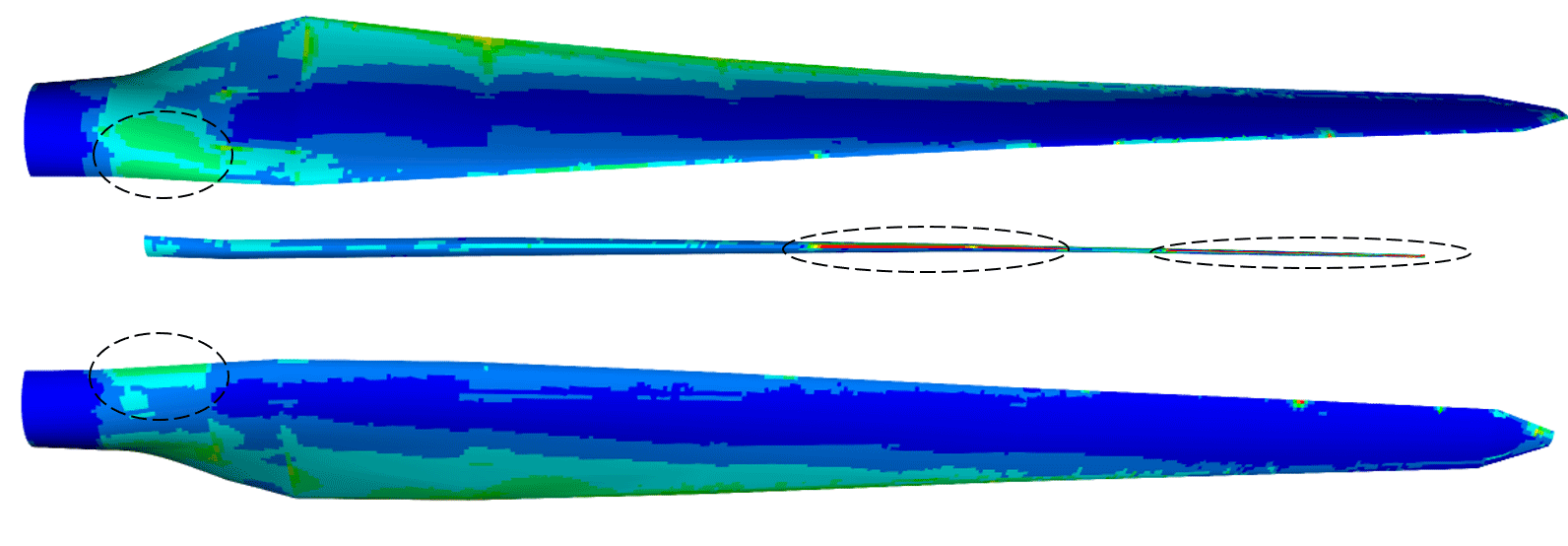
Imagine a serene offshore energy island near Crete, surrounded by the endless blue of the Mediterranean. Now, picture a row of powerful wind turbines standing tall, harnessing the breeze to power Crete towards its 2050 carbon neutrality goal. Sounds cool, right? My team took on the challenge to design one of the critical components for this green energy initiative—the wind turbine blades. But that’s not all; we also developed the hub, nose hub, and pitch drive to ensure these turbines can hum along efficiently for years.
The project mission?
Optimise the design for maximum energy efficiency while keeping costs down. To get there, we dove deep into calculations, CFD (Computational Fluid Dynamics) analysis and FEA (Finite Element Analysis), refining every inch of the blade geometry. Our aim was to design a turbine capable of standing up to offshore conditions while maximising energy capture.
The turbine blade challenge?
Designing turbine blades that could withstand the harsh offshore environment, cope with high wind speeds and remain operational for 25 years—all while maximising energy capture. It wasn’t just about creating sleek, aerodynamic shapes; it was about ensuring these massive structures could endure the intense forces thrown at them.
To achieve this, I performed a detailed FEA that simulated how the blades would behave under various loads, including wind pressure, rotational forces, and environmental stresses. By analysing stress distribution, displacement, and potential points of failure, I fine-tuned the blade design to make it both efficient and incredibly durable.
Here’s the breakdown:
Through FEA, I didn't just design blades that work—I designed blades that are built to last in one of the toughest environments on earth. This detailed analysis helped us refine the geometry, reduce material costs and ensure long-term performance, all while meeting Crete’s renewable energy goals.
First up, we took our blade and simplified it—like chopping a complex recipe down to the essentials. Why? Because trying to model every twist, taper and internal structure is like asking your laptop to run a marathon.
Instead, we created a "solid body" version of the blade and sliced it into manageable parts, focusing on the sections that would see the most stress.
Simplification Tactic: We removed the internal features (webbing and supports) to make the model solvable. This helped us get a quick but reliable overview of the stress distribution.
Reality Check: The solid model slightly underestimates the stress because it doesn’t account for internal structures, but we applied correction factors to adjust for this.


Next came the fun part—applying the real-world conditions. We attached the base of the blade to the turbine hub (that’s our fixed boundary), and then applied a flapwise force (9.77 kN/m) and an edgewise load (16.22 kN/m) to simulate what the blade experiences as the wind blows. It’s like trying to bend a ruler by pushing on one end while the other end is clamped down tight.
Why These Loads? These forces come from the wind interacting with the blade at varying angles and speeds, based on real wind data near Crete.
Now, for the results. FEA showed us where the blade would be under the most stress and how much it would bend. As you might guess, the root of the blade (where it connects to the turbine) takes the brunt of the load. That’s why we reinforced this area in the design.
Maximum Stress: After applying a correction factor, the maximum stress came out to around 2.63 MPa. This is well within the safety limits of the materials we chose (epoxy/E-glass fiber and balsa wood), so no need to worry about our blade cracking under pressure.
Maximum Displacement: The flapwise displacement (how much the blade bends) was a mere 9.54 x 10^-5 meters—super small! This means the blade stays nice and stable, even under heavy wind loads.

FEA doesn’t just stop at numbers—it helps us make sure that the blade won’t deform too much or fail prematurely. We compared our results to industry standards and made sure the blade’s deflections and stresses were within acceptable ranges.
The goal? To ensure the blade can last for 25 years while spinning away in those Mediterranean winds.
Safety Margin: Our blade has a factor of safety well above the required limits, meaning it can handle unexpected loads and harsh conditions without breaking a sweat.
Efficiency: By combining these FEA insights with the results from our CFD analysis, we maximized the blade’s energy capture while ensuring structural integrity. Think of it as getting the best of both worlds—high performance and durability.
And that’s a wrap—from stress testing to material optimisation, the FEA process has pushed every limit, ensuring these blades are ready to withstand anything the offshore environment throws their way!